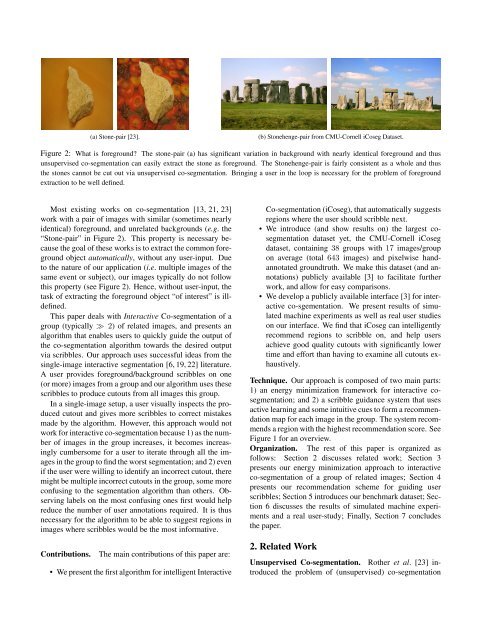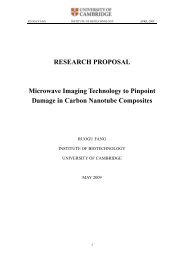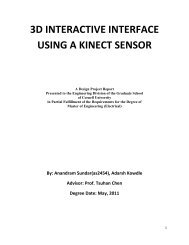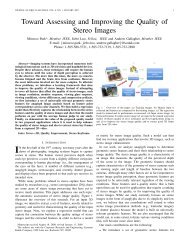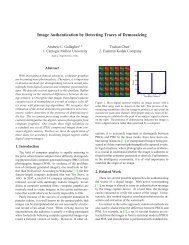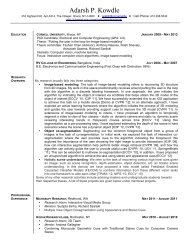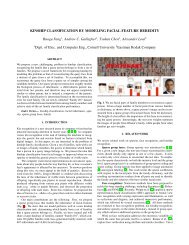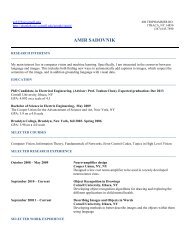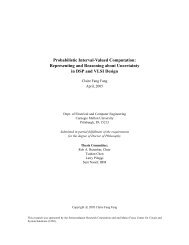iCoseg: Interactive Co-segmentation with Intelligent Scribble Guidance
iCoseg: Interactive Co-segmentation with Intelligent Scribble Guidance
iCoseg: Interactive Co-segmentation with Intelligent Scribble Guidance
Create successful ePaper yourself
Turn your PDF publications into a flip-book with our unique Google optimized e-Paper software.
(a) Stone-pair [23]. (b) Stonehenge-pair from CMU-<strong>Co</strong>rnell <strong>i<strong>Co</strong>seg</strong> Dataset.<br />
Figure 2: What is foreground? The stone-pair (a) has significant variation in background <strong>with</strong> nearly identical foreground and thus<br />
unsupervised co-<strong>segmentation</strong> can easily extract the stone as foreground. The Stonehenge-pair is fairly consistent as a whole and thus<br />
the stones cannot be cut out via unsupervised co-<strong>segmentation</strong>. Bringing a user in the loop is necessary for the problem of foreground<br />
extraction to be well defined.<br />
Most existing works on co-<strong>segmentation</strong> [13, 21, 23]<br />
work <strong>with</strong> a pair of images <strong>with</strong> similar (sometimes nearly<br />
identical) foreground, and unrelated backgrounds (e.g. the<br />
“Stone-pair” in Figure 2). This property is necessary because<br />
the goal of these works is to extract the common foreground<br />
object automatically, <strong>with</strong>out any user-input. Due<br />
to the nature of our application (i.e. multiple images of the<br />
same event or subject), our images typically do not follow<br />
this property (see Figure 2). Hence, <strong>with</strong>out user-input, the<br />
task of extracting the foreground object “of interest” is illdefined.<br />
This paper deals <strong>with</strong> <strong>Interactive</strong> <strong>Co</strong>-<strong>segmentation</strong> of a<br />
group (typically ≫ 2) of related images, and presents an<br />
algorithm that enables users to quickly guide the output of<br />
the co-<strong>segmentation</strong> algorithm towards the desired output<br />
via scribbles. Our approach uses successful ideas from the<br />
single-image interactive <strong>segmentation</strong> [6, 19, 22] literature.<br />
A user provides foreground/background scribbles on one<br />
(or more) images from a group and our algorithm uses these<br />
scribbles to produce cutouts from all images this group.<br />
In a single-image setup, a user visually inspects the produced<br />
cutout and gives more scribbles to correct mistakes<br />
made by the algorithm. However, this approach would not<br />
work for interactive co-<strong>segmentation</strong> because 1) as the number<br />
of images in the group increases, it becomes increasingly<br />
cumbersome for a user to iterate through all the images<br />
in the group to find the worst <strong>segmentation</strong>; and 2) even<br />
if the user were willing to identify an incorrect cutout, there<br />
might be multiple incorrect cutouts in the group, some more<br />
confusing to the <strong>segmentation</strong> algorithm than others. Observing<br />
labels on the most confusing ones first would help<br />
reduce the number of user annotations required. It is thus<br />
necessary for the algorithm to be able to suggest regions in<br />
images where scribbles would be the most informative.<br />
<strong>Co</strong>ntributions. The main contributions of this paper are:<br />
• We present the first algorithm for intelligent <strong>Interactive</strong><br />
<strong>Co</strong>-<strong>segmentation</strong> (<strong>i<strong>Co</strong>seg</strong>), that automatically suggests<br />
regions where the user should scribble next.<br />
• We introduce (and show results on) the largest co<strong>segmentation</strong><br />
dataset yet, the CMU-<strong>Co</strong>rnell <strong>i<strong>Co</strong>seg</strong><br />
dataset, containing 38 groups <strong>with</strong> 17 images/group<br />
on average (total 643 images) and pixelwise handannotated<br />
groundtruth. We make this dataset (and annotations)<br />
publicly available [3] to facilitate further<br />
work, and allow for easy comparisons.<br />
• We develop a publicly available interface [3] for interactive<br />
co-sgementation. We present results of simulated<br />
machine experiments as well as real user studies<br />
on our interface. We find that <strong>i<strong>Co</strong>seg</strong> can intelligently<br />
recommend regions to scribble on, and help users<br />
achieve good quality cutouts <strong>with</strong> significantly lower<br />
time and effort than having to examine all cutouts exhaustively.<br />
Technique. Our approach is composed of two main parts:<br />
1) an energy minimization framework for interactive co<strong>segmentation</strong>;<br />
and 2) a scribble guidance system that uses<br />
active learning and some intuitive cues to form a recommendation<br />
map for each image in the group. The system recommends<br />
a region <strong>with</strong> the highest recommendation score. See<br />
Figure 1 for an overview.<br />
Organization. The rest of this paper is organized as<br />
follows: Section 2 discusses related work; Section 3<br />
presents our energy minimization approach to interactive<br />
co-<strong>segmentation</strong> of a group of related images; Section 4<br />
presents our recommendation scheme for guiding user<br />
scribbles; Section 5 introduces our benchmark dataset; Section<br />
6 discusses the results of simulated machine experiments<br />
and a real user-study; Finally, Section 7 concludes<br />
the paper.<br />
2. Related Work<br />
Unsupervised <strong>Co</strong>-<strong>segmentation</strong>. Rother et al. [23] introduced<br />
the problem of (unsupervised) co-<strong>segmentation</strong>


